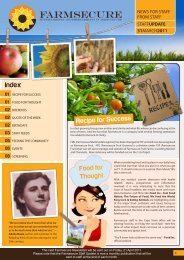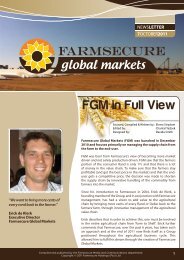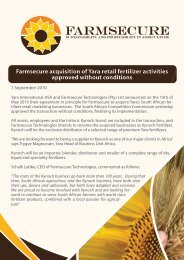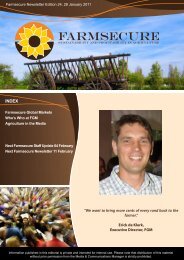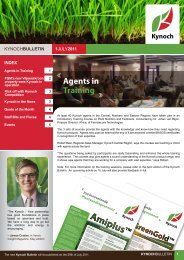Women in Agriculture - Farmsecure
Women in Agriculture - Farmsecure
Women in Agriculture - Farmsecure
Create successful ePaper yourself
Turn your PDF publications into a flip-book with our unique Google optimized e-Paper software.
<strong>Women</strong> <strong>in</strong><br />
<strong>Agriculture</strong><br />
Written by Elvera Strydom<br />
The 9th of August is <strong>Women</strong>’s Day, a day were we<br />
herald the challenges and triumphs that women have<br />
come through. With this m<strong>in</strong>d we thought it relevant<br />
to focus this edition of our newsletter on <strong>Women</strong> <strong>in</strong><br />
<strong>Agriculture</strong>.<br />
<strong>Agriculture</strong> is a major component of rural <strong>in</strong>comes,<br />
especially <strong>in</strong> develop<strong>in</strong>g nations where water, land,<br />
livestock, crops, and knowledge are essential for their<br />
livelihood. Access to, control over, and management<br />
of these resources determ<strong>in</strong>es which activities are<br />
pursued, which goods may be produced, and whether<br />
the lives of rural families are enhanced or dim<strong>in</strong>ished.<br />
Gender determ<strong>in</strong>es who has access to these resources<br />
and what k<strong>in</strong>d of access they have. Although women<br />
<strong>in</strong> develop<strong>in</strong>g nations work <strong>in</strong> the fields, the homes,<br />
outside of the farm, and at the markets, their male<br />
counterparts often dictate decisions over the household<br />
and its economy.<br />
Much of the agricultural work done by women of the<br />
develop<strong>in</strong>g world is subsistence agriculture. While<br />
their husbands often go to the cities or large-scale<br />
farms to f<strong>in</strong>d work, women are often left to produce<br />
and raise food for their children. <strong>Agriculture</strong>, especially<br />
subsistence agriculture, is a way of survival for many<br />
women. Their work, however, is often unrecognised.<br />
Despite a grow<strong>in</strong>g recognition of women’s work and<br />
contributions to agriculture, women cont<strong>in</strong>ue to have<br />
unequal access to necessities such as land, water, credit,<br />
supportive networks, and capital.<br />
The United Nations declared a decade for women<br />
between 1970 and 1980. Despite development efforts<br />
dur<strong>in</strong>g this decade, Sen and Grown (1987) found that<br />
the conditions <strong>in</strong> which women live and work did not<br />
improve. S<strong>in</strong>ce these f<strong>in</strong>d<strong>in</strong>gs surfaced <strong>in</strong> the late 1980s,<br />
researchers have re-focused on the question of why and<br />
found that there were several underly<strong>in</strong>g structures<br />
that prevent women from ga<strong>in</strong><strong>in</strong>g equal social status<br />
to men.<br />
The follow<strong>in</strong>g researchers have contributed to<br />
understand<strong>in</strong>g women’s role <strong>in</strong> agriculture, how<br />
gender discrim<strong>in</strong>ation impedes access to necessary<br />
resources, and how women demand social change.<br />
Chief Editor Chantal Yazbek, Elvera Strydom Sub-editor & Writer, Layout & Design Dieter Strumpher,<br />
Published by <strong>Farmsecure</strong> Hold<strong>in</strong>gs (PTY) LTD.



